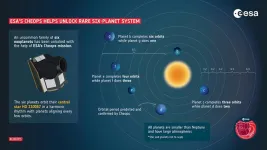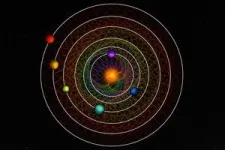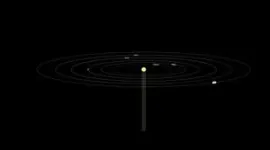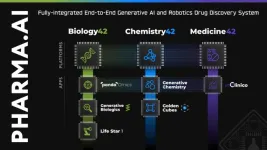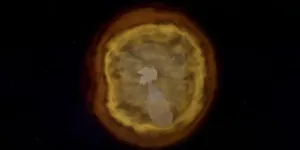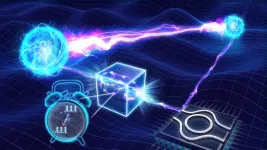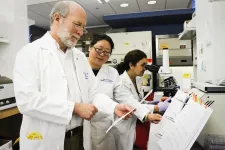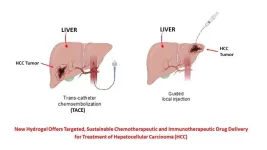(Press-News.org) An international collaboration between astronomers using the CHEOPS and TESS space satellites, including NCCR PlanetS members from the University of Bern and the University of Geneva, have found a key new system of six transiting planets orbiting a bright star in a harmonic rhythm. This rare property enabled the team to determine the planetary orbits which initially appeared as an unsolvable riddle.
CHEOPS is a joint mission by ESA and Switzerland, under the leadership of the University of Bern in collaboration with the University of Geneva. Thanks to a collaboration with scientists working with data from NASA’s satellite TESS, the international team could uncover the planetary system orbiting the nearby star HD110067. A very distinctive feature of this system is its chain of resonances: the planets orbit their host star in perfect harmony. Part of the research team are researchers from the University of Bern and the University of Geneva who are also members of the National Center of Competence in Research (NCCR) PlanetS. The findings have just been published in Nature.
The planets in the HD110067 system revolve around the star in a very precise waltz. When the closest planet to the star makes three full revolutions around it, the second one makes exactly two during the same time. This is called a 3:2 resonance. “Amongst the over 5000 exoplanets discovered orbiting other stars than our Sun, resonances are not rare, nor are systems with several planets. What is extremely rare though, is to find systems where the resonances span such a long chain of six planets” points out Dr. Hugh Osborn, CHEOPS fellow at the University of Bern, leader of CHEOPS observation programme involved in the study, and co-author of the publication. This is precisely the case of HD110067 whose planets form a so-called “resonant chain” in successive pairs of 3:2, 3:2, 3:2, 4:3, and 4:3 resonances, resulting in the closest planet completing six orbits while the outer-most planet does one.
A seemingly unsolvable puzzle
Although multiple planets were initially detected thanks to their transits, the exact arrangement of the planets was unclear at first. However, the precise gravitational dance enabled the scientists’ team to solve the puzzle of HD110067. Prof. Adrien Leleu from the University of Geneva, in charge of analysing the orbital resonances, and co-author of the study, explains: “A transit occurs when a planet, from our point of view, passes in front of its host star, blocking a minute fraction of the starlight, creating an apparent dip of its brightness.” From the first observations carried out by NASA’s TESS satellite, it was possible to determine that the two inner planets called ‘b’ and ‘c’ have orbital periods of 9 and 14 days respectively. However, no conclusions could be drawn for the other four detected planets as two were seen to transit once in 2020 and once in 2022 with a large 2-year gap in the data, and the other two transited only once in 2022.
The solution to the puzzle for those four additional planets finally began to emerge thanks to observations with the CHEOPS space telescope. While TESS aims at scanning all of the sky bit by bit to find short-period exoplanets, CHEOPS is a targeted mission, focusing on a single star at a time with exquisite precision. “Our CHEOPS observations enabled us to find that the period of planet ‘d’ is 20.5 days. Also, it ruled out multiple possibilities for the remaining three outer planets, ‘e’, ‘f’ and ‘g’,” reveals Osborn.
Predicting the precise waltz of the planets
That is when the team realized that the three inner planets of HD110067 are dancing in a precise 3:2, 3:2 chain of resonances: when the innermost planet revolves nine times around the star, the second revolves six times and the third planet four times.
The team then considered the possibility that the three other planets could also be part of the chain of resonances. “This led to dozens of possibilities for their orbital period,” explains Leleu, “but combining existing observational data from TESS and CHEOPS, with our model of the gravitational interactions between the planets, we could exclude all solutions but one: the 3:2, 3:2, 3:2, 4:3, 4:3 chain.” The scientists could therefore predict that the outer three planets (‘e’, ‘f’ and ‘g’) have orbital periods of 31, 41 days, and 55 days.
This prediction allowed to schedule observations with a variety of ground-based telescopes. Further transits of planet ‘f’ were observed, revealing it was precisely where theory predicted it based on the resonant-chain. Finally, reanalysis of the data from TESS revealed two hidden transits, one from each of planets ‘f’ and ‘g’, exactly at the times expected by the predictions, confirming the periods of the six planets. Additional CHEOPS observations of each planet, and in particular planet ‘e’ are scheduled in the near future.
A key system for the future
From the handful of resonant-chain systems found so far, CHEOPS has highly contributed to the understanding of not only HD110067, but also of TOI-178. Another well-known example of a resonant-chain system is the TRAPPIST-1 system which hosts seven rocky planets. However, TRAPPIST-1 is a small and incredibly faint star which makes any additional observations very difficult. HD110067, on the other hand, is more than 50 times brighter than TRAPPIST-1.
“The fact that the planets in the HD110067 system have been detected by the transit method is key. While they pass in front of the star, light also filters through the planetary atmospheres” points out Jo Ann Egger, PhD student at the University of Bern, who computed the composition of the planets using CHEOPS data, and co-author of the study. This property is allowing astronomers to determine the chemical composition and other properties of the atmospheres. Since a lot of light is required, the bright star HD110067 and its orbiting planets are an ideal target for further studies to charachterize the planetary atmospheres. “The sub-Neptune planets of the HD110067 system appear to have low masses, suggesting they may be gas- or water-rich. Future observations, for example with the James Webb Space Telescope (JWST), of these planetary atmospheres could determine whether the planets have rocky or water-rich interior structures,” concludes Egger.
Publication details:
“A resonant sextuplet of sub-Neptunes transiting the bright star HD 110067” by R. Luque et al. is published in Nature on November 29, 2023.
DOI https://doi.org/10.1038/s41586-023-06692-3
Contacts:
Dr. Hugh Osborn (French/English)
Physics Institute, Space Research & Planetary Sciences (WP), University of Bern and NCCR PlanetS
E-Mail: hugh.osborn@unibe.ch
Tel: +41 31 684 36 08
Dr. Adrien Leleu (French/English)
Département d’Astronomie, University of Geneva and Physics Institute, Space Research & Planetary Sciences (WP), University of Bern and NCCR PlanetS
E-Mail: adrien.leleu@unige.ch
Tel: +41 22 379 24 68
Jo Ann Egger (German/English)
Physics Institute, Space Research & Planetary Sciences (WP), University of Bern and NCCR PlanetS
E-Mail: jo-ann.egger@unibe.ch
Tel: +41 31 684 52 42
CHEOPS – in search of potential habitable planets
The CHEOPS mission (CHaracterising ExOPlanets Satellite) is the first of ESA’s “S-class missions” – small-class missions with an ESA budget much smaller than that of large- and medium-size missions, and a shorter timespan from project inception to launch.
CHEOPS is dedicated to characterizing the transits of exoplanets. It measures the changes in the brightness of a star when a planet passes in front of that star. This measured value allows the size of the planet to be derived, and for its density to be determined on the basis of existing data. This provides important information on these planets – for example, whether they are predominantly rocky, are composed of gases, or if they have deep oceans. This, in turn, is an important step in determining whether a planet has conditions that are hospitable to life.
CHEOPS was developed as part of a partnership between the European Space Agency (ESA) and Switzerland. Under the leadership of the University of Bern and ESA, a consortium of more than a hundred scientists and engineers from eleven European states was involved in constructing the satellite over five years.
CHEOPS began its journey into space on Wednesday, December 18, 2019 on board a Soyuz Fregat rocket from the European spaceport in Kourou, French Guiana. Since then, it has been orbiting the Earth on a polar orbit in roughly an hour and a half at an altitude of 700 kilometers following the terminator.
The Swiss Confederation participates in the CHEOPS telescope within the PRODEX program (PROgramme de Développement d'EXpériences scientifiques) of the European Space Agency ESA. Through this program, national contributions for science missions can be developed and built by project teams from research and industry. This transfer of knowledge and technology between
science and industry ultimately also gives Switzerland a structural competitive advantage as a business location – and enables technologies, processes and products to flow into other markets and thus generate added value for our economy.
More information: https://cheops.unibe.ch/
Bernese space exploration: With the world’s elite since the first moon landing
When the second man, "Buzz" Aldrin, stepped out of the lunar module on July 21, 1969, the first task he did was to set up the Bernese Solar Wind Composition experiment (SWC) also known as the “solar wind sail” by planting it in the ground of the moon, even before the American flag. This experiment, which was planned, built and the results analyzed by Prof. Dr. Johannes Geiss and his team from the Physics Institute of the University of Bern, was the first great highlight in the history of Bernese space exploration.
Ever since Bernese space exploration has been among the world’s elite, and the University of Bern has been participating in space missions of the major space organizations, such as ESA, NASA, and JAXA. With CHEOPS the University of Bern shares responsibility with ESA for a whole mission. In addition, Bernese researchers are among the world leaders when it comes to models and simulations of the formation and development of planets.
The successful work of the Department of Space Research and Planetary Sciences (WP) from the Physics Institute of the University of Bern was consolidated by the foundation of a university competence center, the Center for Space and Habitability (CSH). The Swiss National Fund also awarded the University of Bern the National Center of Competence in Research (NCCR) PlanetS, which it manages together with the University of Geneva.
Exoplanet research in Geneva: 25 years of expertise awarded a Nobel Prize
CHEOPS provides crucial information on the size, shape, formation and evolution of known exoplanets. The installation of the "Science Operation Center" of the CHEOPS mission in Geneva, under the supervision of two professors from the UNIGE Astronomy Department, is a logical continuation of the history of research in the field of exoplanets, since it is here that the first was discovered in 1995 by Michel Mayor and Didier Queloz, winners of the 2019 Nobel Prize in Physics. This discovery has enabled the Astronomy Department of the University of Geneva to be at the forefront of research in the field, with the construction and installation of HARPS on the ESO's 3.6m telescope at La Silla in 2003, a spectrograph that remained the most efficient in the world for two decades to determine the mass of exoplanets. ESPRESSO is the latest spectrograph built in Geneva and installed on the VLT in Paranal, and it is now reaching an even higher precision than HARPS.
CHEOPS is therefore the result of two national expertise, on the one hand the space know-how of the University of Bern with the collaboration of its Geneva counterpart and on the other hand the ground experience of the University of Geneva supported by its colleague in the Swiss capital. Two scientific and technical competences that have also made it possible to create the National Center of Competence in Research (NCCR) PlanetS
END
An astronomical waltz reveals a sextuplet of planets
2023-11-29
ELSE PRESS RELEASES FROM THIS DATE:
Final call for Awards Nominations 2024 of the World Cultural Council
2023-11-29
The World Cultural Council (WCC) is now accepting nominations for the “Albert Einstein” World Award of Science and the “Leonardo da Vinci” World Awards of Arts.
Nominations must be submitted by 26 January, 2024. NOMINATE NOW: To nominate online or for further details of the awards visit the WCC website Nominations page.
Ideal candidates for the “Albert Einstein” World Award of Science are scientists whose achievements can serve as an inspiration for future generations. This award is granted each year. Consideration will be given to ...
BU/VA researcher awarded funding to prevent intimate partner violence
2023-11-29
(Boston)—Casey Taft, PhD, professor of psychiatry at Boston University Chobanian & Avedisian School of Medicine, has been approved for a five-year, $2.8 million funding award from the Patient-Centered Outcomes Research Institute (PCORI) for his research study “A Randomized Controlled Trial to Evaluate a Trauma-Informed Partner Violence Intervention Program.”
Taft, who also is a staff psychologist at the National Center for PTSD in the VA Boston Healthcare System, is conducting a randomized controlled trial of the Strength at Home program to prevent and end intimate partner violence (IPV) in Rhode Island. Strength at Home ...
The act of saying "no" under the linguistic magnifying glass
2023-11-29
FRANKFURT. Prof. Bernhard Brüne, Vice President Research, Early Career Researchers and Transfer at Goethe University Frankfurt, congratulated the researchers involved in the successful application: "Anyone who establishes a major project like a Collaborative Research Center must have both creative and viable research ideas as well as a strong network. To discover new things about language and thinking, the new CRC 1629 not only makes use of Goethe University’s structures, and the combination of philology with philosophy and didactics. It also cooperates with partner universities in Göttingen and Tübingen. Aside that, I am of course delighted that ...
Insilico Medicine showcases latest AI drug discovery platform breakthroughs
2023-11-29
Insilico Medicine (“Insilico”), an artificial intelligence (AI)-driven, clinical stage biotechnology company and leader in AI drug discovery platform technology, is hosting three webinars unveiling its latest technology breakthroughs Nov. 28-30, 2023. These new features are part of the expansion of the Company’s end-to-end Pharma.AI platform and include chat functionality, off-target screening tools, enhanced knowledge graphs and more. They represent major steps forward in the advancement of AI drug discovery.
The company is an early ...
New astrophysics model sheds light on additional source of long gamma-ray bursts
2023-11-29
Cutting-edge computer simulations combined with theoretical calculations are helping astronomers better understand the origin of some of the universe’s most energetic and mysterious light shows — gamma-ray bursts, or GRBs. The new unified model confirms that some long-lasting GRBs are created in the aftermath of cosmic mergers that spawn an infant black hole surrounded by a giant disk of natal material.
Astronomers previously thought that black holes that generate long GRBs typically form when massive ...
Brain scans of former NFL athletes show a repair protein in place long after initial injury
2023-11-29
FOR IMMEDIATE RELEASE
In a new study using brain scans of former NFL athletes, Johns Hopkins Medicine researchers say they found high levels of a repair protein present long after a traumatic brain injury such as a concussion takes place. The repair protein, known as 18 kDa translocator protein (TSPO), is known to be present in the brain at high levels in the immediate aftermath of brain injury as part of the inflammatory response and to facilitate repair. The new findings, published Oct. 30 in JAMA Network Open, suggest that brain injury and repair processes persist for years after players end collision sports careers, and lead to long-term cognitive ...
Long-live quantum entanglement goes to distance
2023-11-29
Quantum technologies are currently maturing at a breath-taking pace. These technologies exploit principles of quantum mechanics in suitably engineered systems, with bright prospects such as boosting computational efficiencies or communication security well beyond what is possible with devices based on today’s 'classical' technologies. As with classical devices, however, to realise their full potential, quantum devices will need to be networked. In principle, this can be done using the fibre-optic networks employed for classical telecommunications. But practical implementation requires that the information ...
To build better tuberculosis vaccines, Saint Louis University researchers develop a new model by leveraging an old vaccine
2023-11-29
ST. LOUIS – Each year, tuberculosis (TB) kills more people than any other infectious disease, falling out of the top spot only temporarily during the COVID-19 pandemic.
Despite TB’s wide reach and some lost progress during the COVID-19 pandemic, researchers believe it is possible to eradicate TB through advances in vaccine development and public health. To cross the finish line, scientists must find ways to test new vaccines rapidly to prevent TB infections more effectively.
In a paper published in the Journal of Infectious Diseases, Daniel Hoft, M.D., Ph.D., ...
Improving our understanding of the effects of PFOS on fish
2023-11-29
Two papers recently published in Environmental Toxicology and Chemistry have made important advancements toward understanding the effects of perfluorooctane sulfonate (PFOS) on aquatic life, especially fish. Zebrafish had been identified in a previous study of limited scope as being among one of the most sensitive aquatic species to PFOS, and the results of that limited-scope study have influenced PFOS water quality criteria derived by some regulatory agencies, including the Australian Environmental Protection Agency (EPA).
Kurt Gust and ...
Enhanced treatment of liver carcinoma with a drug-eluting hydrogel
2023-11-29
(LOS ANGELES) – November 29, 2023 - Scientists from the Terasaki Institute for Biomedical Innovation (TIBI) have developed an injectable or catheter-administered hydrogel with enhanced capabilities for treating hepatocellular carcinoma (HCC), a deadly form of liver cancer. As described in their recent publication in Advanced Functional Materials, this drug-eluting hydrogel can provide sustained, pH-dependent drug co-delivery and has capabilities for promoting anti-tumor immune responses. This reduces tumor cell proliferation and growth and offers a more efficient means of enabling tumor cell death.
Worldwide, HCC is a leading cause of ...
